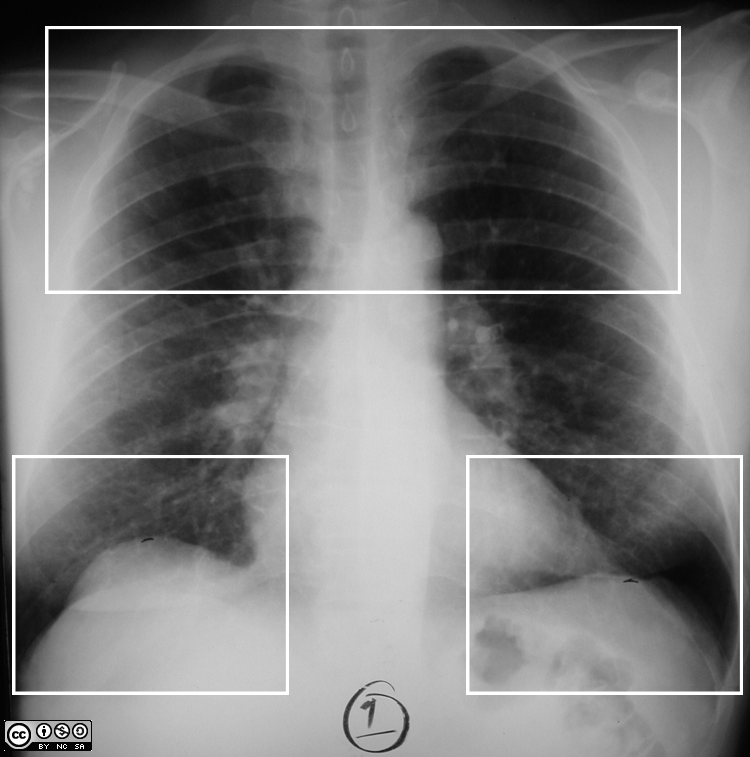 |
||||||||||||||||||||||||||||||||||||||||||||||||||||||
| Module 4: Cases in Occupational Medicine |
CASE 1: A scrap metal smelter operator
A 50 year old employee of a scrap metal company was referred to a pulmonologist suffering from progressive breathlessness, fatigue and a productive cough. He had been at the company for 7 years. He had a history of smoking 3 cigarettes a day. Physical findings included clubbing and basal crackles heard in the lung. Sputum was negative for tuberculosis. An early x-ray was regarded as abnormal and interstitial fibrosis was confirmed on CT scan of the lungs. Open lung biopsy showed a fibrosing alveolitis.
His occupational history was as follows. For 9 years he worked for the government printing works servicing machines, with exposure to oils and lubricants. For one year he worked as an operator for an engineering company, with exposure to oils but not to metal dust. He then worked for a company manufacturing electrical transformers.
Question #1:
What hazardous substance might electrical transformers contain?
His next job was for an iron and steel works smelting steel. His job was that of refractory furnace builder.
Question #2:
What hazard comes to mind here?
For the last 8 years of his working life until he retired ill, he worked for a scrap metal smelting company. His job included some exposure to silica powder used when the smelting furnace was relined. This was done every second month. He wore a respirator during this operation.
He worked in a large open shed with two furnaces ("reduction furnaces") into which the scrap metal was placed manually. His main exposure was to fumes and particulate from the smelting operation. The main metals smelted were "gunmetal" (bronze) and brass. Car radiators were frequently smelted. Iron was smelted only occasionally. These mainly non-ferrous metals were then cast into ingots.
He was treated by his pulmonologist with oral steroids with some improvement in symptoms and lung function. The pulmonologist made a second diagnosis of asthma for which the patient received inhaled therapy as well. Because of his exposure to metals, his case was submitted as an occupational lung disease under COIDA, but the claim was rejected. The patient was then referred to the Occupational Diseases Clinic for assistance.
The chest x-ray at the time of his first visit to the clinic (shown below) was more or less normal. A later x-ray showed loss of volume and increased irregular opacities at the lung bases. (Clicking on one of the marked rectangular areas on the x-ray will provide a magnified view).


Question #3:
What might the differences between the two x-ray films be due to?
His lung functions were as follows:
| Spirometry | March 1997 | Predicted | % | April 2002 | Predicted | % |
|---|---|---|---|---|---|---|
| FEV1 (litres) | 2.7 | 3.5 | 77 | 3.1 | 3.4 | 91 |
| FVC (litres) | 3.4 | 4.3 | 79 | 4.1 | 4.2 | 97 |
| FEV1/FVC | 81 | 78 | 75 | 78 | ||
| Diffusion | ||||||
| TLCO | 11.7 | 29.7 | 39 | 19.1 | 29.1 | 66 |
| KCO | 2.2 | 5.6 | 39 | 3.4 | 5.5 | 62 |
Question #4:
What is your interpretation?
Question #5:
How would you proceed to try to establish whether his disease was occupational?
His main exposure was to fumes and particulate from the smelting operation. The main metals smelted were "gunmetal" (bronze - containing 70% copper, 6% zinc, 6% tin, 3% manganese, 2% iron, 2% silica and 1% aluminium) and brass (40% copper, 40% zinc, 5% aluminium, 4% manganese, 3% selenium, 3% iron, 2% silica and 1% lead).
He described the ventilation as poor. There was local extraction via a canopy with ducting, pulled over the furnace. Reportedly, windy conditions would result in fumes being blown back into the factory. He wore a respirator with a cartridge, changing it every second day.
Question #6:
Are any of these metals associated with fibrosing alveolitis?
Question #7:
Given that the patient was exposed to iron, could this be siderosis?
The lung tissue block was sent to the National Centre for Occupational Health laboratory in Johannesburg for metal analysis. The results showed the presence of copper (17.5 µg/g dry tissue) and zinc (78.8 µg/g dry tissue). Tin could not be assayed. No reference levels were available.
Question #8:
How would you interpret these findings?
The literature review yields the following studies: Study 1 and Study 2.
Question #9:
Is this patient’s disease occupational?
Question #10:
What advice would you give the patient regarding his recourse under COIDA?
Final outcome: The objection went to a hearing and liability was accepted. The patient was eventually awarded 35 percent permanent disablement 5 years after the initial claim.

Postgraduate Diploma in Occupational Health (DOH) - Modules 3 – 5: Occupational Medicine & Toxicology by Prof Rodney Ehrlich & Prof Mohamed Jeebhay is licensed under a Creative Commons Attribution-NonCommercial-ShareAlike 3.0 Unported License.
Permissions beyond the scope of this license may be available at http://www.healthedu.uct.ac.za/